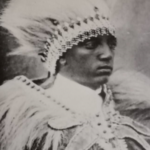MIKAEL SEHUL
- 3 Min Read
Ras Mikael Sehul (1688-1775) was the de facto ruler of Ethiopia for 40 years, from 1730s to the 1770s. These years witnessed the inception of the period called the ‘Zamana Masafent’, or “Age of the Judges”, during which all central government broke down.
He came from a humble family of the region of Tamben near Aksum. As a young man he was chamberlain to Ras Andi Haymanot, the semi-independent governor of the territories east of the Takkaze river. Ethiopia had been unsettled since the invasion of Muslim forces from Adal, led by Ahmad ibn Ibrahim [Ahmad Gran] in the earlier 16th century. Regional factions had been revived, the authority of the emperors had declined, and powerful provincial governors could play the role of kingmakers.
Mikael Sehul rebelled, and defeated and killed his former master, becoming governor of his territories. He bought many firearms from the Turks, and became the undisputed master of his provinces. Emperor Iyasu II [reigned 1730-1755] invited him to Gondar to suppress the Galla and chiefs of the other rebellious groups. Later Mikael Sehul became Ras of the empire, protector and, (having married Wayzaro Esther, the daughter of Queen Mentewab), father-in-law of Emperor Iyoas (reigned 1753-1769), who was the son and successor of Iyasu II.
A quarrel over the fate of some important prisoners, who were executed by orders of Iyoas against Sehul’s will, and the miscarriage of Iyoas’ plans to oust him, cost the emperor his life. Sehul then brought the late emperor’s aged uncle from confinement and enthroned him as Yohannes II. Too feeble for Sehul, he was poisoned after a “role” of only five months. A fifteen-year-old son of this poisoned emperor was then enthroned as Takla Haymanot II on October 18, 1769.
Sehul’s cruelty and pride caused his once-faithful generals to rebel. Since he was not strong enough to face them, he retreated to his native province, taking the emperor with him. During Sehul’s absence, a new emperor, Susneyos, was crowned in Gondar. With the support of a former rival, who had been frustrated in his attempt to seize power under the new emperor, Sehul marched against Gondar in 1770. Susneyos fled and vanished from the scene. Massacres followed, and the archbishop of the Ethiopian Orthodox Church was hanged for having supported Susneyos.
Sehul, who had become old and infirm, tried to suppress a coalition of chiefs against him, but failed, and was taken prisoner. His life was, however, spared, and he was confined for a year to a distant province. He was then reinstated in his old province of Tamben, where he died of old age.
Although his ambition to become emperor was not fulfilled, because he was a regicide and lacked Solomonian descent, he was nevertheless the founder of the house that was later to produce Emperor Yohannes IV [reigned 1872-1889]. He was an able general, an astute politician, and an implacable judge.
BEMNET GABRE AMLAK



